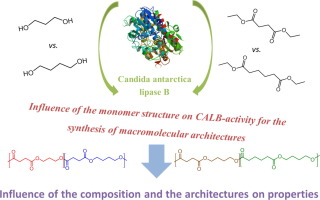当前位置:
X-MOL 学术
›
Eur. Polym. J.
›
论文详情
Our official English website, www.x-mol.net, welcomes your
feedback! (Note: you will need to create a separate account there.)
Lipase-catalyzed synthesis of biobased and biodegradable aliphatic copolyesters from short building blocks. Effect of the monomer length
European Polymer Journal ( IF 5.8 ) Pub Date : 2017-12-01 , DOI: 10.1016/j.eurpolymj.2017.10.028 Thibaud Debuissy , Eric Pollet , Luc Avérous
European Polymer Journal ( IF 5.8 ) Pub Date : 2017-12-01 , DOI: 10.1016/j.eurpolymj.2017.10.028 Thibaud Debuissy , Eric Pollet , Luc Avérous

|
Abstract Biobased short aliphatic diols and diethyl carboxylates were enzymatically (co)polymerized in solution at mild temperature using the immobilized form of Candida antarctica lipase B (CALB) as biocatalyst. The influence of the monomer structure on the CALB activity was investigated. CALB showed a better affinity for 1,4-butanediol compared to 1,3-propanediol (1,3-PDO), whereas no preference was observed between diethyl succinate and diethyl adipate. In addition, two series of random copolyesters [poly(butylene succinate-ran-butylene adipate) (PBSA) and poly(propylene succinate-ran-butylene succinate) (PPBS)] were synthesized at different compositions to investigate the effect of the composition on copolyesters, which were fully characterized by various chemical and physico-chemical techniques including NMR, SEC, WAXS, DSC and TGA. Their compositions were similar to the feed ones, despite the activity difference of the monomers towards CALB. Nevertheless, this activity difference resulted in the decrease of the Mw of PPBS from 24 to 11 kg/mol for 1,3-PDO content varying from 0 to 100 mol.%. Moreover, 1,3-PDO induced an increase of Tg and a decrease of the crystallization rate until having an amorphous behavior for high 1,3-PDO content. On the other side, the reduction of the diethyl carboxylate chain length from diethyl adipate to diethyl succinate did not induce a clear tendency with Mn varying from 22 to 12 kg/mol with the succinate content. Furthermore, Tg increased with the succinate content and the good thermal stability of copolyesters were dependent on the diethyl carboxylates composition. Finally, both copolyesters exhibited an isodimorphic co-crystallization behavior.
中文翻译:

脂肪酶催化从短结构单元合成生物基和可生物降解的脂肪族共聚酯。单体长度的影响
摘要 使用固定化形式的南极念珠菌脂肪酶 B (CALB) 作为生物催化剂,在温和的温度下在溶液中酶促(共)聚合生物基短脂肪族二醇和羧酸二乙酯。研究了单体结构对CALB活性的影响。与 1,3-丙二醇 (1,3-PDO) 相比,CALB 对 1,4-丁二醇表现出更好的亲和力,而在琥珀酸二乙酯和己二酸二乙酯之间没有观察到偏好。此外,以不同的组成合成了两个系列的无规共聚酯 [聚(丁二酸丁二酯 - 己二酸丁二酯)(PBSA)和聚(丁二酸丙二酯 - 丁二酸丙二酯)(PPBS)],以研究该组合物对共聚酯,它们通过各种化学和物理化学技术进行了充分表征,包括 NMR、SEC、WAXS、DSC 和 TGA。尽管单体对 CALB 的活性存在差异,但它们的组成与进料相似。然而,对于 1,3-PDO 含量从 0 到 100 mol.% 的变化,这种活性差异导致 PPBS 的 Mw 从 24 kg/mol 降低到 11 kg/mol。此外,1,3-PDO 导致 Tg 增加和结晶速率降低,直到具有高 1,3-PDO 含量的无定形行为。另一方面,羧酸二乙酯链长从己二酸二乙酯到琥珀酸二乙酯的减少没有引起明显的趋势,随着琥珀酸含量的Mn从22到12kg/mol变化。此外,Tg 随琥珀酸酯含量的增加而增加,共聚酯的良好热稳定性取决于羧酸二乙酯的组成。最后,
更新日期:2017-12-01
中文翻译:

脂肪酶催化从短结构单元合成生物基和可生物降解的脂肪族共聚酯。单体长度的影响
摘要 使用固定化形式的南极念珠菌脂肪酶 B (CALB) 作为生物催化剂,在温和的温度下在溶液中酶促(共)聚合生物基短脂肪族二醇和羧酸二乙酯。研究了单体结构对CALB活性的影响。与 1,3-丙二醇 (1,3-PDO) 相比,CALB 对 1,4-丁二醇表现出更好的亲和力,而在琥珀酸二乙酯和己二酸二乙酯之间没有观察到偏好。此外,以不同的组成合成了两个系列的无规共聚酯 [聚(丁二酸丁二酯 - 己二酸丁二酯)(PBSA)和聚(丁二酸丙二酯 - 丁二酸丙二酯)(PPBS)],以研究该组合物对共聚酯,它们通过各种化学和物理化学技术进行了充分表征,包括 NMR、SEC、WAXS、DSC 和 TGA。尽管单体对 CALB 的活性存在差异,但它们的组成与进料相似。然而,对于 1,3-PDO 含量从 0 到 100 mol.% 的变化,这种活性差异导致 PPBS 的 Mw 从 24 kg/mol 降低到 11 kg/mol。此外,1,3-PDO 导致 Tg 增加和结晶速率降低,直到具有高 1,3-PDO 含量的无定形行为。另一方面,羧酸二乙酯链长从己二酸二乙酯到琥珀酸二乙酯的减少没有引起明显的趋势,随着琥珀酸含量的Mn从22到12kg/mol变化。此外,Tg 随琥珀酸酯含量的增加而增加,共聚酯的良好热稳定性取决于羧酸二乙酯的组成。最后,











































 京公网安备 11010802027423号
京公网安备 11010802027423号